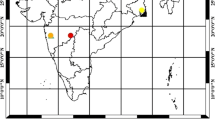Abstract
PM2.5, a principal constituent of particulate matter, is the most deadly form of air pollution attributing to significant number of health problems. For a country like India with a vast topographical distribution, the existing number of ground-based stations for monitoring of pollutant concentration is inadequate. With the advent of technology, remote sensing-based monitors have been able to capture the pollutant concentrations of any region. Using a combined Dark Target and Deep Blue (DTB) Terra and Aqua Moderate Resolution Imaging Spectroradiometer (MODIS) Level 3 aerosol optical depth (AOD) product and surface PM2.5 measurements from Central Pollution Control Board (CPCB) monitors, we provide a decade (2010–2020) of assessment of AOD–PM2.5 relationships all over India by graphical analysis and simple linear regression analysis. This study analyse the factors which can affect the relationship observed between the two datasets over various regions and at different times. Region-wise, state-wise and season-wise analyses for correlation were carried out. In addition, analyses were also carried out based on pollutant concentration levels and for 2020 lockdown period. Regardless of the classification, the two datasets were found to have a high correlation to one another. In general, Northern regions tend to show higher correlations, however the relation was found to be independent of concentration of pollutants. Post-monsoon and winter season showed comparatively higher correlation. The regression analysis for a general equation all over India yielded a linear equation with R2 = 0.92 and a root mean square error of 26.84 µg/m3. Overall, our evaluation shows that MODIS Level 3 data estimates of PM2.5 on an annual time scale using simple linear models are reliable.
Access this chapter
Tax calculation will be finalised at checkout
Purchases are for personal use only
Similar content being viewed by others
References
Navinya CD, Vinoj V, Pandey SK (2020) Evaluation of PM2.5 surface concentrations simulated by NASA’s MERRA version 2 aerosol reanalysis over india and its relation to the air quality index. Aerosol Air Qual Res 20(6):1329–1339
Apte JS, Marshall JD, Cohen AJ, Brauer M (2015) Addressing global mortality from ambient PM2.5. Environ Sci Technol 49(13):8057–8066
Central Pollution Control Board (2020) Government of India, “CPCB,” [Online]. Available: https://cpcb.nic.in/. Accessed 15 Sept 2020
Central Pollution Control Board (2003) Ministry of environment and forests, Guidelines for ambient air quality monitoring, National Ambient Air Quality Monitoring Series: NAAQMS
Ministry of Home Affairs (2020) Government of India, Census of India—Office of the Registrar General and Census Commissioner, India [Online]. Available: https://censusindia.gov.in/2011common/censusdata2011.html. Accessed 15 Sept 2020.
URBANemissions.info [Online]. Available: https://urbanemissions.info/india-air-quality/india-ambient-monitoring-data/. Accessed 15 Sept 2020
Shaddick G, Thomas ML, Green A, Brauer M, Donkelaar AV, Burnett R, Chang HH, Cohen A, Dingenen RV, Dora C, Gumy S, Liu Y, Martin R, Waller LA, West J, Zidek JV, Prüss-Ustün A (2017) Data integration model for air quality: a hierarchical approch to the global estimation of exposures to ambient air pollution. J Roy Stat Soc: Ser C (Appl Stat) 67(1):231–253
Brauer M, Guttikunda SK, Nishad KA, Dey S, Tripathi SN, Weagle C, Martin RV (2019)Examination of monitoring approaches for ambient air pollution: A case study for India. Atmos Environ 216
Dey S, Purohit B, Balyan P, Dixit K, Bali K, Kumar A, Imam F, Chowdhury S, Ganguly D, Gargava P, Shukla VK (2020) A satellite-based high-resolution (1-km) ambient PM2.5 database for India over two decades (2000–2019): applications for air quality management. Remote Sens 12(23)
Gordon T, Balakrishnan K, Dey S, Rajagopalan S, Thornburg J, Thurston G, Agrawal A, Collman G, Guleria R, Limaye S, Salvi S, Kilaru V, Nadadur S (2018) Air pollution health research priorities for India: perspectives of the Indo-U.S. communities of researchers. Environ Int 119:100–108
Gupta P, Christopher SA, Wang J, Gehrig R, Lee Y, Kumar N (2006) Satellite remote sensing of particulate matter and air quality assessment over global cities. Atmos Environ 40:5880–5892
Mishra RK, Agarwal A, Shukla A (2020) Predicting ground level PM2.5 concentration over delhi using landsat 8 satellite data. Int J Remote Sens 42(3):827–838
Wang J, Christopher SA (2003) Intercomparison between satellite-derived aerosol optical thickness and PM2.5 mass: implications for air quality studies. Geophys Res Lett 30(21)
Wei J, Lia Z, Peng Y, Sun L (2019) MODIS Collection 6.1 aerosol optical depth products over land and ocean: validation and comparison. Atmos Environ 201:428–440
Wei J, Peng Y, Guo J, Sun L (2019) Performance of MODIS Collection 6.1 Level 3 aerosol products in spatial-temporal variations over land. Atmos Environ 206:30–44
NASA (2020) Giovanni, Earthdata [Online]. Available: https://giovanni.gsfc.nasa.gov/giovanni/. Accessed 2020 Sep 15
Chang JC, Hanna S (2004) Air quality model performance evaluation. Meteorol Atmos Phys 87:167–196
Guttikunda SK, Calori G (2013) A GIS based emissions inventory at 1 km × 1 km spatial resolution for air pollution analysis in Delhi, India. Atmos Environ 67(2013):101–111
Chen Y, Wild O, Conibear L, Ran L,. He J, Wang L, Wang Y (2020) Local characteristics of and exposure to fine particulate matter (PM2.5) in four Indian megacities. Atmospheric Environ: X 5:100052
Acknowledgements
We wish to acknowledge Central Pollution Control Board (CPCB) for their open access to PM2.5 data and also the Giovanni online data system, developed and maintained by the NASA GES DISC for making the data available for public use from where the required MODIS AOD data used to carry out the study were collected.
Author information
Authors and Affiliations
Corresponding author
Editor information
Editors and Affiliations
Rights and permissions
Copyright information
© 2023 The Author(s), under exclusive license to Springer Nature Singapore Pte Ltd.
About this paper
Cite this paper
Scaria, H.P., Avanthika, P., Jose, A.M., Alisa, J.S., Sadasivan, A., Varghese, G.K. (2023). Relational Study of PM2.5 Surface Concentration with MODIS Level 3 AOD Data Over India. In: Nandagiri, L., Narasimhan, M.C., Marathe, S. (eds) Recent Advances in Civil Engineering. CTCS 2021. Lecture Notes in Civil Engineering, vol 256. Springer, Singapore. https://doi.org/10.1007/978-981-19-1862-9_7
Download citation
DOI: https://doi.org/10.1007/978-981-19-1862-9_7
Published:
Publisher Name: Springer, Singapore
Print ISBN: 978-981-19-1861-2
Online ISBN: 978-981-19-1862-9
eBook Packages: EngineeringEngineering (R0)




